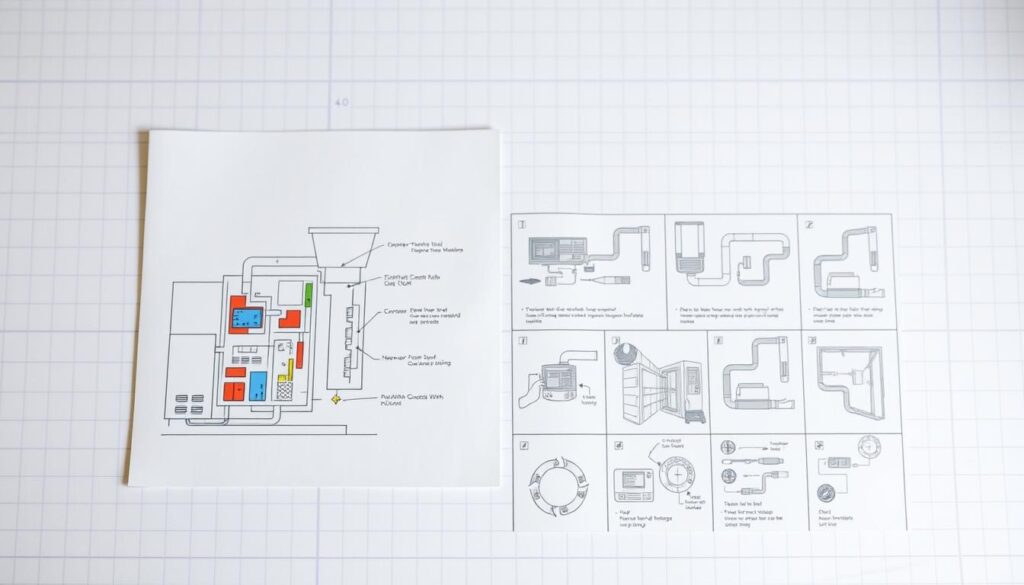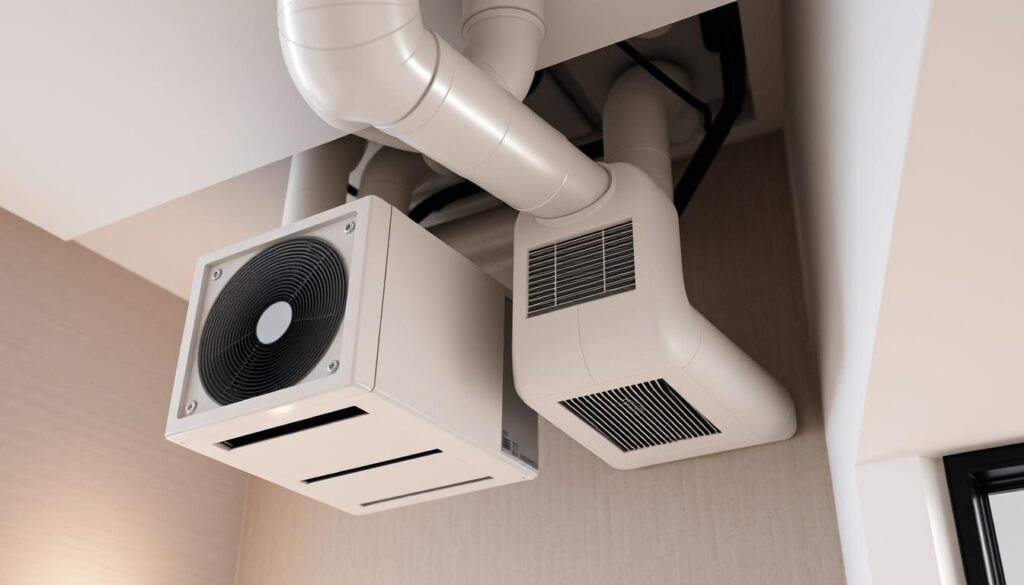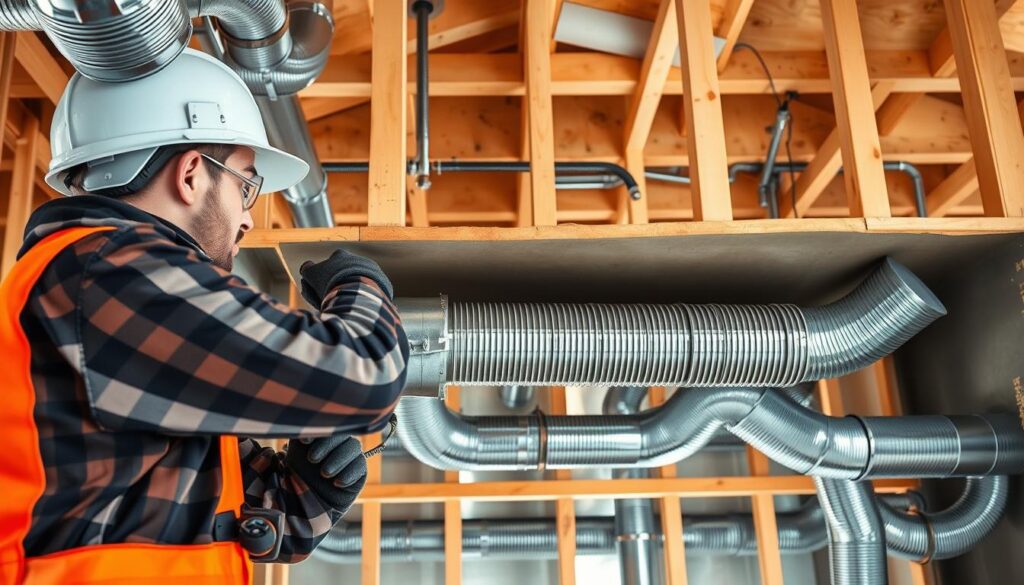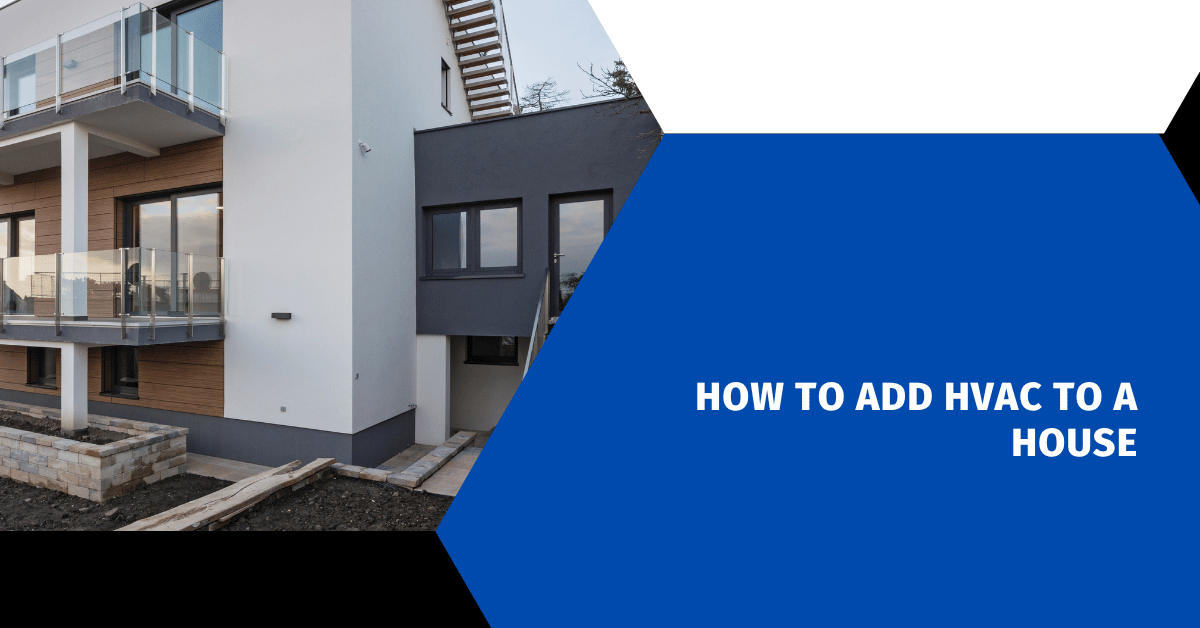Affiliate Disclosure
HVAC Guide Guys is a participant in the Amazon Services LLC Associates Program, an affiliate advertising program designed to provide a means for sites to earn advertising fees by advertising and linking to Amazon.
How to Add HVAC to a House? Are you tired of hot summers and cold winters? Wondering how to make your home more comfortable? Adding a home HVAC system might be the answer you’ve been looking for.

Adding HVAC to your house can seem daunting. But with the right help, you can make your home cozy all year round. Home HVAC systems do more than just control the temperature. They turn your home into a cozy haven.
This guide will help you through every step of installing a home HVAC system. You’ll learn how to pick the right equipment and understand the installation process. You’ll get the info you need to control your home’s climate wisely.
Key Takeaways
- HVAC systems provide comprehensive home temperature control
- Proper installation requires professional assessment and planning
- Energy efficiency is crucial when selecting an HVAC system
- Different home layouts require customized HVAC solutions
- Regular maintenance ensures long-term system performance
Table of Contents
Understanding HVAC System Types and Components
Choosing the right home hvac systems is key to comfort. You need to know the different types and components. This ensures your system works well with your home’s layout.
There are various home hvac systems, each designed for cooling and heating. You’ll mainly see split and packaged units.
Split AC Systems vs Packaged Units
Split AC systems are flexible and efficient for many homes. They have:
- Separate indoor and outdoor units
- Improved energy efficiency
- Quieter operation
- More customizable installation
Packaged units are a compact option. They have all parts in one unit. They’re best for:
- Smaller homes
- Limited installation space
- Simpler maintenance requirements
Essential HVAC Components
| Component | Function |
|---|---|
| Compressor | Circulates refrigerant and transfers heat |
| Condenser Coil | Releases heat from refrigerant to outside air |
| Evaporator Coil | Absorbs indoor heat and cools air |
| Air Handler | Circulates conditioned air throughout home |
Role of Ductwork in HVAC Systems
Ductwork is crucial for your central air conditioning. Properly designed ducts ensure even air distribution. They help with energy efficiency and keep temperatures steady.
When choosing home hvac systems, think about your needs, home layout, and budget. A professional can help you make the best choice for comfort and performance.
Explore Our HVAC Shop
Looking for top-rated HVAC tools, parts, and accessories? Visit our shop and find the perfect solution for your needs.
Visit the ShopCalculating the Right HVAC System Size for Your Home
Finding the perfect HVAC system for your home is all about precision. It’s about getting the right size, which affects how well it works, your comfort, and your energy bills over time.
Experts use a special method called the Manual J Load Calculation to find the best system for your home. This method looks at more than just how big your home is.
Understanding the Manual J Load Calculation Process
The Manual J Load Calculation looks at several important factors:
- Total square footage of living spaces
- Insulation quality and types
- Window quantity, size, and orientation
- Number of home occupants
- Local climate conditions
BTU and Tonnage Explained
When sizing your HVAC system, experts use two main measurements:
- BTU (British Thermal Units): Shows how much heat it can remove
- Tonnage: Shows its cooling power (1 ton = 12,000 BTUs)
“Proper HVAC sizing is not about bigger being better, but about precision and efficiency.” – HVAC Industry Expert
Home Size and Layout Considerations
Your home’s unique features greatly affect what HVAC system you need. Things like ceiling height, room layout, and how much sun it gets are key. They help decide the best system for keeping your home cool and warm efficiently.
Explore Our HVAC Shop
Looking for top-rated HVAC tools, parts, and accessories? Visit our shop and find the perfect solution for your needs.
Visit the ShopCost Breakdown for How to Add HVAC to a House
Understanding the cost of adding an HVAC system is key to planning your budget. The cost depends on several factors that can change the total price.
When you think about adding HVAC to your home, you’ll face several costs:
- HVAC Unit Costs: Central AC units usually cost between $2,500 and $4,500
- Installation fees range from $3,500 to $7,000
- There are also costs for ductwork and electrical upgrades
Your total cost will depend on a few important things:
- Home size
- System efficiency rating
- How complex the installation is
- Local labor rates
- Costs for permits and inspections
Different HVAC systems have different prices. A split system might be cheaper but harder to install. Packaged units can be simpler and less expensive for some homes.
Pro tip: Always get multiple quotes from certified HVAC professionals to ensure competitive pricing and quality installation.
If you’re watching your budget, think about energy-efficient models. They might cost more at first but save money in the long run by using less energy.
Energy Efficiency Considerations and Modern Features
Choosing home hvac systems now means focusing on energy efficiency. Homeowners want to cut down on utility bills and help the environment. New heating and cooling tech offers advanced solutions for better comfort and performance.

Knowing about energy efficient heating and cooling is key. It helps you make smart choices for your home’s climate control:
SEER Ratings and Energy Standards
The Seasonal Energy Efficiency Ratio (SEER) is important for judging HVAC system performance. Federal rules now require air conditioning units to have a SEER of at least 13. Higher SEER numbers mean better energy use:
- SEER 13-15: Standard efficiency
- SEER 16-20: High efficiency
- SEER 21+: Premium efficiency
Smart Technology Integration
Today’s home hvac systems come with smart tech for better comfort and energy use. These features let you:
- Change the temperature from your phone
- Set up your own heating and cooling schedules
- See how much energy you’re using live
Noise Reduction Features
New energy efficient systems also have advanced noise reduction. They use special designs for compressors and fans to make less noise. This makes your home quieter and more peaceful.
Getting a modern HVAC system with high efficiency can save you money in the long run. It also makes your home more comfortable.
Explore Our HVAC Shop
Looking for top-rated HVAC tools, parts, and accessories? Visit our shop and find the perfect solution for your needs.
Visit the ShopPreparing Your Home for HVAC Installation
Getting ready for hvac installation needs careful planning and thorough preparation. Your home must be considered in detail for a smooth setup. Proper preparation can save you time, money, and avoid complications.
Begin with a comprehensive home assessment. This step is crucial to find potential challenges for your hvac installation. You should focus on several key areas:
- Evaluate existing ductwork for potential leaks or damage
- Check home insulation quality
- Clear space for indoor and outdoor units
- Ensure proper electrical infrastructure
- Verify structural support for equipment
Ductwork inspection is very important for home hvac systems. Hidden issues like blockages or poor insulation can significantly reduce system efficiency. HVAC contractors suggest a thorough examination to fix any problems before starting.
“Preparation is the key to a successful HVAC installation. Take time to understand your home’s unique requirements.” – HVAC Installation Expert
Creating enough workspace is another key step. Move furniture, clear paths, and ensure easy access for technicians. This helps technicians work better and minimizes disruptions.
Think about getting a professional home energy audit before installation. This can give you more insights into your home’s heating and cooling needs. It helps you make better choices for your new hvac systems.
Ductwork Installation and Modifications
Ductwork is like the heart of your HVAC system, making sure air flows well in your home. Getting it right is key for comfort and system efficiency.

When setting up your ductwork, several important things affect how well your HVAC system works.
Planning Duct Routes
Planning duct routes needs careful thought about your home’s layout. You want to:
- Keep turns and bends to a minimum
- Make air flow as straight as possible
- Steer clear of walls and other obstacles
- Make sure air is evenly distributed
Material Selection
The materials you choose for ductwork affect its long-term performance. Here are some options:
| Material | Durability | Cost | Best Used For |
|---|---|---|---|
| Flexible Ducts | Medium | Low | Tight spaces, complex routes |
| Sheet Metal Ducts | High | Medium-High | Main trunk lines, straight runs |
| Fiberglass Ducts | High | Medium | Noise reduction, thermal insulation |
Installation Techniques
Installing ductwork needs precise measurements and careful placement. Proper sealing and insulation are vital to stop air leaks and keep energy use down.
Ductwork installation costs can be from $1,500 to $6,000. This depends on your home’s size, material choice, and how complex the job is. Quality ductwork means your HVAC system works its best.
Solutions for Homes Without Existing Ductwork
Older homes often struggle with installing traditional HVAC systems. But, there are new ways to heat and cool without big changes to your home. These options are energy efficient and don’t require major renovations.
There are two main choices for homeowners looking for flexible HVAC solutions:
- Ductless Mini-Split Systems: These systems have an outdoor unit and indoor units connected by lines. They offer:
- Easy installation
- Control over each room’s temperature
- High energy savings
- High-Velocity Systems: These systems use small tubes to move air. They:
- Need little to no changes to your home
- Send cool air fast
- Are great for small spaces
When picking a solution, think about your home’s design, your budget, and what you need for comfort. HVAC experts can guide you to find the best fit for your home.
Now, you can keep your home’s original charm while enjoying today’s comfort with advanced ductless tech.
Explore Our HVAC Shop
Looking for top-rated HVAC tools, parts, and accessories? Visit our shop and find the perfect solution for your needs.
Visit the ShopProfessional Installation Process and Timeline
Ready to get your hvac installed? Knowing the professional steps can make you feel more at ease. Home hvac experts have a clear plan to set up your system smoothly and quickly.
The day of installation is key to your home’s comfort change. Your chosen hvac pros will follow a detailed plan. This ensures your system works its best.
Site Preparation Essentials
Getting the site ready is vital for a good hvac install. Your contractors will do the following:
- Clear the area of furniture and stuff
- Protect floors and nearby areas
- Check if the electrical and structure are ready
- Do a final check of the site
Systematic Installation Sequence
The install process is done in a specific order. This helps avoid problems and ensures quality:
- Take out old equipment (if there is any)
- Put in the indoor unit mounting
- Place the outdoor condensing unit
- Connect the refrigerant lines
- Install and seal the ductwork
- Do the electrical connections
Comprehensive Final Testing
After installing, your hvac pros will test everything thoroughly. They check:
- Refrigerant levels
- Electrical connections
- If the system starts up and works right
- How well it moves air and keeps temperature
“A professional installation ensures your HVAC system operates at peak efficiency from day one.” – HVAC Industry Expert
Pro tip: Always ask for a detailed guide on how to use and maintain your new system from your install team.
Permits, Codes, and Legal Requirements
Understanding hvac permits and codes is key before starting your HVAC project. You must know the legal rules to ensure your system is safe and follows local standards.
Residential hvac contractors know getting the right permits is a must. Each area has its own rules for HVAC installations, which can differ a lot.
- Building Permits: Required for most structural changes
- Electrical Permits: Needed for electrical connections
- Mechanical Permits: Specific to HVAC installations
Your local building department will tell you what you need. Usually, you’ll have to provide detailed plans, system specs, and proof of contractor license.
| Permit Type | Average Cost | Processing Time |
|---|---|---|
| Building Permit | $250-$500 | 1-2 weeks |
| Electrical Permit | $100-$300 | 3-5 business days |
| Mechanical Permit | $150-$400 | 5-7 business days |
Choosing licensed residential hvac contractors makes getting permits easier. They know the local rules, ensuring your installation is up to code and passes inspections.
Pro tip: Always check your contractor’s license and insurance before starting any HVAC project.
Explore Our HVAC Shop
Looking for top-rated HVAC tools, parts, and accessories? Visit our shop and find the perfect solution for your needs.
Visit the ShopMaintenance and Care for New HVAC Systems
Keeping your HVAC system in top shape is key. It ensures your home stays cool in summer and warm in winter. Regular maintenance tips help your system work efficiently for years.
Your HVAC system needs regular care to run smoothly. Create a maintenance plan. It should include tasks you can do yourself and visits from professionals.
- Change air filters every 3 months
- Clean outdoor units quarterly
- Schedule annual professional inspections
- Check thermostat settings seasonally
Air filters are very important. Dirty filters make your system work harder. This means it uses more energy and might wear out faster.
Here are more ways to keep your system efficient:
- Keep vents and registers clean and unobstructed
- Seal any ductwork leaks
- Maintain consistent thermostat settings
- Clear debris around outdoor units
Experts say get a full system check every year. This catches problems early and saves you money. It also keeps your system running well without sudden breakdowns.
Regular maintenance is your best investment in long-term HVAC system reliability and efficiency.
Conclusion
Adding an HVAC system to your house is a big home improvement project. It needs careful planning and smart decisions. You now know a lot about choosing, installing, and keeping your HVAC system running well.
Starting your HVAC project means looking at your home’s needs and picking the right tech. You’ll need to think about your budget and what you want in comfort. Getting help from pros and doing your homework will help you avoid problems and make good choices.
Getting a good HVAC system is more than just being comfy. It also saves energy, can raise your home’s value, and improves air quality. With what you’ve learned, you’re ready to install a system that fits your home perfectly.
Good HVAC systems come from careful planning, expert setup, and regular care. Knowing these important steps will help you make your home a cozy, efficient, and welcoming place.

